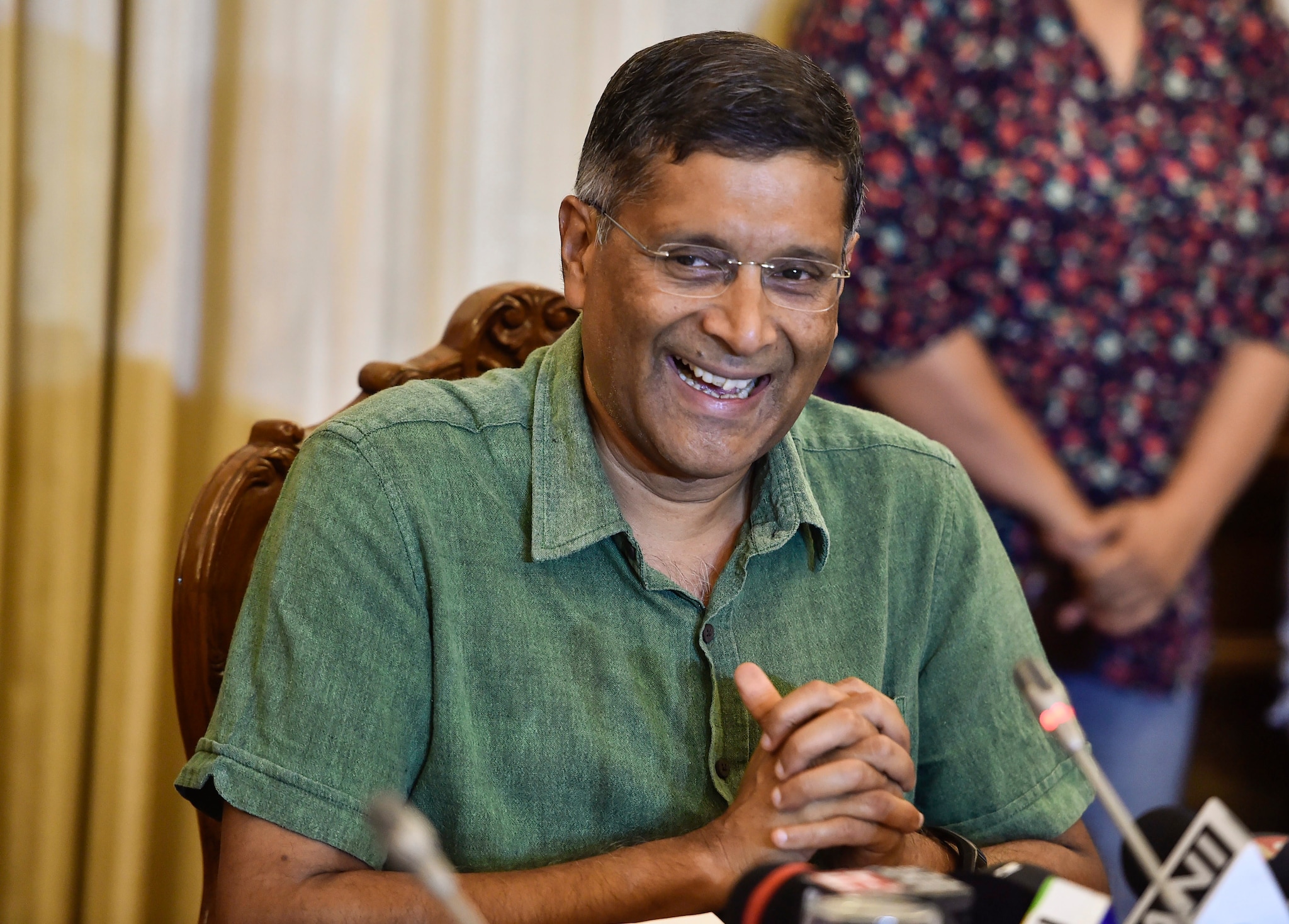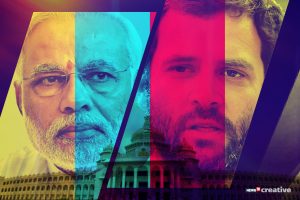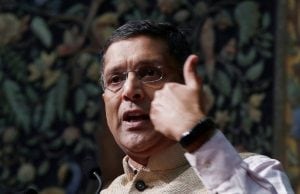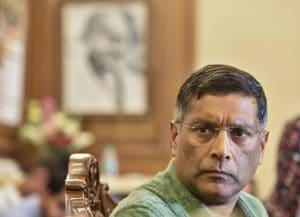RBI must do an asset quality review on NBFCs, says former CEA Arvind Subramanian

KV Prasad Jun 13, 2022, 06:35 AM IST (Published)
 Listen to the Article (6 Minutes)
Listen to the Article (6 Minutes)
Summary
Subramaniam said the Reserve Bank of India (RBI) must do an asset quality review of non-banking finance companies (NBFCs) so that everyone knows the size of the problem.
Arvind Subramanian, 16th chief economic adviser to the government of India, is a widely cited expert on the economics of India, China, and the changing balance of global economic power. Formerly an economist at the International Monetary Fund, Subramanian is non-resident senior fellow at the Peterson Institute for International Economics and a visiting lecturer in public policy at Harvard University’s Kennedy School of Government.
Served at the General Agreement on Tariffs and Trade (GATT) from 1988 to 1992 during the Uruguay Round of trade negotiations and previously taught at Harvard University’s Kennedy School of Government and Johns Hopkins’ School for Advanced International Studies, Subramanian obtained his undergraduate degree from St. Stephens College, his MBA from the Indian Institute of Management at Ahmedabad, and his M.Phil and D.Phil from the University of Oxford.
Subramaniam said the Reserve Bank of India (RBI) must do an asset quality review of non-banking finance companies (NBFCs) so that everyone knows the size of the problem. Talking on government-Reserve Bank of India (RBI) tussle over utilisation of capital reserves, Subramanian said the excess capital of the central bank must be used to recapitalise the banks.
Edited excerpts
Q: Let me start with the introduction – the way you have ended your introduction chapter is somewhat despondent. It looks to me the question is whether things may have to once again turn really bad before they get better. Even in the earlier paragraph you say the problems of the twin balance sheet need to be addressed quickly. Make no mistake, the passage of time will erode the country’s resolve and we are sitting at the last year of this five-year term, which was ushered in with great promise by people like us, 335 majority. We thought this is the turning point, but when you read these paragraphs, you seem to be a little disappointed about the last five years.
A: As I say, overall some major actions were taken and I would say – the Goods and Services Tax (GST) was a big achievement. I think the Insolvency and Bankruptcy Code (IBC) finally provided a way forward for the twin balance sheet challenge and I also think that this whole — new alternative vision — it is a kind of socialist, welfarist vision of the Prime Minister, which is providing private essential services using the states, using the technology to deliver this and health, housing, toilets, power etc. I think these are big achievements for which the government deserves a lot of credit.
As I say, some things are not done – the Air India privatisation is still there.
I mentioned also, agriculture continues to be a source of anxiety and of course manufacturing exports also have languished.
So, I think that some big achievements, some more things could have been done and some setbacks. I think the return of protectionism is also a bit of a setback. While the new vision of using the state to provide goods and services is a defining thing, it’s also true that some of the state has made a comeback in other areas, which I mentioned in the book and I kind of attribute that to some extent to what I call stigmatised capitalism, which is a long pervading phenomenon.
So, the state is back in some good ways that we thought wouldn’t happen. The Hindustan Petroleum Corporation Ltd (HPCL) episode, the LIC-IDBI deal, so the state is back and I do think that is due to stigmatised capitalism. I think it is not a short run, it is not due to this government and I think it has been there for a very long time. I would say that one of the things that after four years I feel perhaps the most muted about is the the twin balance sheet challenge and this is one of the things I say in book, it is almost eight years and counting, IBC’s tremendous breakthrough but despite that, I think we have still some way to go. Suddenly, new problems have emerged, kind of out of left field or right field whichever it is. So, unless we kept the financial system on to a solid basis going forward, I think it will always take a toll on the economy.
Q: This is a serious statement, can things get worse before they get better.
A: Yes, so I think it is related to my general view that – I said this in my first survey – big bang reforms, as it were, usually occur in the aftermath of crisis.
Q: Not when you have a 335 majority.
A: I think the political economy, when you have to take serious action, you need that kind of background. As I said in the book, I thought we had that moment – when the Nirav Modi scandal happened and it passed.
For example, in the twin balance sheet, I have always said some amount of majority private sector participation is essential, which means the bank nationalisation act has to be changed and you have to overcome a lot of more position.
So if that is the case, you need that spur and that spur only comes when you have the crisis.
I am told that former Prime Minister Narsimha Rao was asked about all this, he sat quietly and then at one point he said, do you have any options. That kind of summarises it all.
Q: I wanted to ask you about IBC that is part of your despondency. It is 18 months since the first 12 cases were taken to the IBC and they have not been resolved.
A: I think we agree that the IBC was the only game in town. Remember, I had advocated a bad bank earlier on, didn’t fly, maybe for good reasons, I am not sure but we have this. However, we discovered with the IBC, still the deadlines have slipped. Only three-four cases have resolved and even those have been in the steel sector and there is a huge overload coming. Then there is power, which is sui generis. I say in the book that power should be treated as sui generis and then there is a new non-banking financial companies (NBFC) problem.
So I have a new idea which I want to put on the table. Raghuram Rajan’s asset quality review had a very salutary impact in pushing this as there was a number, there was a big number we all knew there was a problem, I think the asset quality review (AQR). I criticised Raghu saying that maybe he should have come earlier, but that is a different conversation. However, the fact was very important as it then mobilises action. So, I am wondering whether we should not have a similar AQR tightening for the NBFCs, because again this is one of those situations where everyone knows or thinks, but no one is willing to be explicit about it and so the not-being explicit maybe demobilised actions. So, I am wondering whether we should have something like that. Put the thing on the table and then generate the political momentum for that as well.
Q: I didn’t want to steal your thunder, but there have been discussions whether AQR should be done on NBFCs. Even the mention of such a thing may again push distrust into the system and block the flow of money. So they may not do it now at all and they may have to wait for complete normalcy to return but be that as it may. There are several questions in what you have just said – the sui generis. You are almost saying that power should be given a forbearance for now out of the February 12 circular.
A: I think forbearance would be one way of characterising it. I don’t see it as forbearance or not forbearance. The reason I say power should be different is for a completely different set of reasons, more analytical and conceptual. One – these are very good assets, they are to liquidate them and it seems like real tragedy. On the other hand, we also know that if you put them for bidding, they will probably have command a very low price, so you can neither sell them nor liquidate them and I think that a lot of the power thing also has to do with the government policy, centre, states, banks and whatever. So it seems to me that the size is huge, a lot of policy preconditions are required and so the straight jacket of the IBC might not suit that. So, I don’t think it is a question of forbearance of delay or whatever, but it seems like a different beast altogether, which requires treatment.
Q: There has been a huge pushback from industry and from government against the Reserve Bank of India’s (RBI) February 12 circular. You have rightly criticised that the AQR or non-performing assets (NPA) recognition and resolution should have started earlier and should have been much bigger. Now, the point is when the RBI said that it’s not going resolved in six months in the National Company Law Tribunal (NCLT), look at the push back and that is at the heart of the government-RBI standoff at the moment. The words are heard in the corridors of north block is yes, we wanted a clean-up, but we didn’t want an irrational clean-up. So, this is the problem that the regulator faces. Looking back you say, they didn’t do enough, but when they are doing, they are irrational. Do you think that it is irrational at all, wasn’t it needed?
A: Certainly, a lot of things that the RBI is trying to do are welcome. For example, on the prompt correction action (PCA) framework, just by way of background, we all know there is an election calendar, we cannot ignore that, this is politics. But what I would like people to step back and view this as – if this were a one year problem or a two year problem, maybe we say let us tied it over till appropriate circumstances arise and we address it again, but this is 8-9 years as I say. It is a long time. So, the more you procrastinate on this, the more it seems to me that not only the chances get worse, but the problem accumulates.
Q: So do the PCA, stick with it.
A: I would, in my four Rs, the reform, one is what you do with the medium to good banks, some of them need to be privatised at some point, but what you do with the unviable ones? PCA is governor YV Reddy’s original thing and you basically shrink that.
Now, I think that unless we do that, we don’t get a banking system that looks efficient, like four-five reasonably big sized banks and I think we have to find a way for those unviable banks.
I think we should pursue that as that is part of the reform solution, because consolidation is not a viable alternative. We know that.
Q: You cannot, weak plus weak gives weak.
A: Yes, weak plus strong maybe also weakens the strong. So I think that I would very much favour the PCA framework remaining and being strengthened. I think the RBI has done a very good job on that.
Just to add to that, I heard for example, someone saying that we must grow our way out of a PCA problem. It struck me that it was the imprudent lending that got us into this in the first place. So if you lend more, I think lending more if you had better governance, better incentive structure, you can be more confident, but if this is going to be a repeat of the past, then I do worry about that.
Q: There is one culpability when I went through your book very rapidly that is not being addressed, the governance part of government is not delivered. You spoke about power and that is why it occurred to me. Yes, you can postpone the power problem and maybe it is willy-nilly getting postponed by the courts, but the government has not kept its part of the bargain. One expected a lot from Ujwal DISCOM Assurance Yojana (UDAY), but what happened actually was that distribution companies (DISCOMs) loans became state government loans. So, actually banks earned less because now you have a solid borrower. But the fall in aggregate technical and commercial (AT&C) losses, the fall in pilferage, all that never happened and when DISCOMs continue to sell 100 units, but get paid for 70 units, they are not signing new power purchase agreements (PPAs). So the real problem of creating the bad power assets actually lies with governance, isn’t it?
A: I haven’t seen the latest UDAY figures myself and the AT&C loss etc. But if what you are saying is right, then the financial part of it went through, but the real reform part maybe hasn’t gone through. I don’t know.
Q: It has fallen a little bi, but nowhere near the targets.
A: I have a chapter on power in this book and this sector has always struck me as an area where it is not just government governance. I think it is an area where it has to be central governments and state governments coming together in the cooperative federalism framework like we did for the GST, because I think the problems of power are very serious. That is another reason why you need a sui generis thing, because you need not just a central government, but the state government also needs to come into the picture. Then you have NTPC and all kinds of things, and to the extent that it hasn’t happened, you are right. I think there has been a shortfall, but I do think that we need to treat this in a kind of cooperative federalism framework and sui generis framework.
Q: Let me just come to the NBFC issue. One of the reasons why I think the RBI doesn’t want to let out banks from the PCA is they very much fear that they may buy up the bad loans of the NBFCs. You think that is a legitimate fear? They were made to lend to infrastructure when probably the danger was not understood. Now if they let out of PCA, they may end up buying the wrong loans?
A: If you allow them to lend more, they could lend wrong. If you were confident that the underlying governance structure had changed, but that hasn’t happened. So I would be extremely cautious about – instinctively I don’t buy this. We can lend our way out of the problem.
Q: Let me come to that dramatic statement, page 99. Let me read your own sentence, “Why didn’t the draconian, the 86 percent reduction in the cash supply have bigger effects on the overall economic growth. To put this more provocatively, the question was not whether demonetisation imposed cost, it clearly did, but why did it not impose much greater costs?” You say in the introduction chapter, this is a subject for several PhD thesis. My point is, did you try to convince the government of this at all, you say that you got to know about it only after it was announced?
A: I say nothing of that sort in the book.
Q: You said on November 8, I saw the Prime Minister announcing it.
A: As I said, this is not a kiss and tell memoir.
Q: I won’t accuse you of saying what you have not said, but were there discussions that we made a mistake, this is not playing the way we planned?
A: This unfolded the way it did. Coming back to the book in the survey, we gave a framework what are the costs and what are the benefits. First, there were costs on the informal sector, which we said very clearly potential benefits and all this is playing out. In the book, I don’t want to go and rehash right/wrong and who said what.
Now, I am a researcher and I have genuinely new questions to ask on this, which is very important because it says a lot about the Indian economy. The first one is why if we think it imposed so much costs on the informal sector, why was it then so politically successful in the Uttar Pradesh elections.
I have a slightly provocative hypothesis, because I think this is a worldwide phenomenon, why do people vote against their self-interest?
In the US, this questions is asked all the time, so this is along those lines and I want people to think about this.
The second puzzle, which has created all this furor is I was asking the question that this 86 percent reduction, you call it draconian, bold, severe, structural shock and by the way it was meant to be bold and draconian and it was not intended as half-hearted measure. But if you take away 86 percent, you ask any economist in the world what is going to be the GDP impact and how this was modeled and it was clear that most models would say huge impact on measured GDP. So, the question I ask is why it wasn’t there in this case.
Q: I asked this question to myself?
A: I think understanding this would tell us a lot about the Indian economy, which we did not know. First is the question of whether we are measuring the wrong thing and that is one issue we need to address – formal, informal and how we measure.
The other, we as a monetary economist don’t understand, maybe substitute between of cash and other forms of money that is one.
The third, is the Indian economy so resilient that we have all these informal arrangements on or even the fourth possibility is that did it lead to a lot debt and did it play out and so on.
I think these are really important questions that I want people to focus on. Draconian, severe you take your pick of word, but that is not the point, it is to understand why action and impact were so disconnected.
Q: Something maybe answered in January or February, as the final estimate of FY17 growth number actually comes two years later. So January 2019, when the new GDP figure of two-years ago comes, maybe something will refined.
A: On the before/after comparisons, in this survey and the book I say that there was decoupling of the Indian economy – whatever number you take 1-2 percent. But there were four factors that contributed to that namely demonetisation, GST, oil prices and high interest rates. So, disentangling that is going to be very difficult, but all four of them contributed to the slowdown in the Indian economy from 2016 to 2017-18.
Q: Now from your perch outside, there are couple of attacks on the RBI. One, there is one person politically inclined to ruling party, who has been appointed. He is educated and qualified Chartered Accountant, but still aligned to the political party and who knows the next government may want two, because a precedent has been broken. As well the Section 7 was alluded to, they did not give directions, but started consultations and then something like Basel norms. The RBI was asked to tone down the amount of capital required. From the outside, is this seen as an attack on RBI? Should we now start becoming careful?
A: I am just transmitting from the outside that it has certainly been a big issue and people do worry. I have been critical of the RBI, but it is a great institution, one of India’s independent institution. In the long run, we know that having sold institutions is good for long-term development.
So the perceptions are getting affected by it. I also worry about the new vision that is creeping in terms of broadly how the financial sector should be run and I think we need to reflect on that.
Q: What are you referring to?
A: I kind of see a new vision. We have to lend money to SMEs, we have to open spigots, we just have solve corruption and everything will solve itself.
I don’t think we should politicise the RBI board. I think it is of an advisory nature and we should maintain its independence.
I think there are some things that are sacrosanct – because it is a loaded word and as the risk of being misconstrued, I think independence yes, over politicising is not good. We should also have a cooperating relationship.
The independence is not mutually exclusive with consultation and cooperation on both sides. I was able to criticise the RBI on several instances, because that underlying thing is we respect each other, we know both are doing this in the public good. As long as that is there, I think we can move forward and I am kind of pleased that we are heading towards that kind of truce hopefully.
Q: You have passionately loved your job, which comes through in every page and every chapter, then why did you leave early?
A: We had very strong personal reasons.
Q: Yes we know that your grandchild had arrived. But grandchild would have waited one year or your children could have brought the grandchild to you and you could still have completed your term. Is there a disappointment you are not telling us?
A: Nobody is irreplaceable in this government.
Q: But is there a disappointment that you are not revealing to us?
A: No, it is all there in the book whatever it is.

Elon Musk forms several ‘X Holdings’ companies to fund potential Twitter buyout
3 Mins Read
Thursday’s filing dispelled some doubts, though Musk still has work to do. He and his advisers will spend the coming days vetting potential investors for the equity portion of his offer, according to people familiar with the matter

KV Prasad Journo follow politics, process in Parliament and US Congress. Former Congressional APSA-Fulbright Fellow


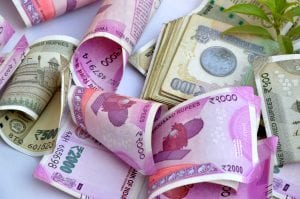






 Listen to the Article
Listen to the Article 
 Daily Newsletter
Daily Newsletter






